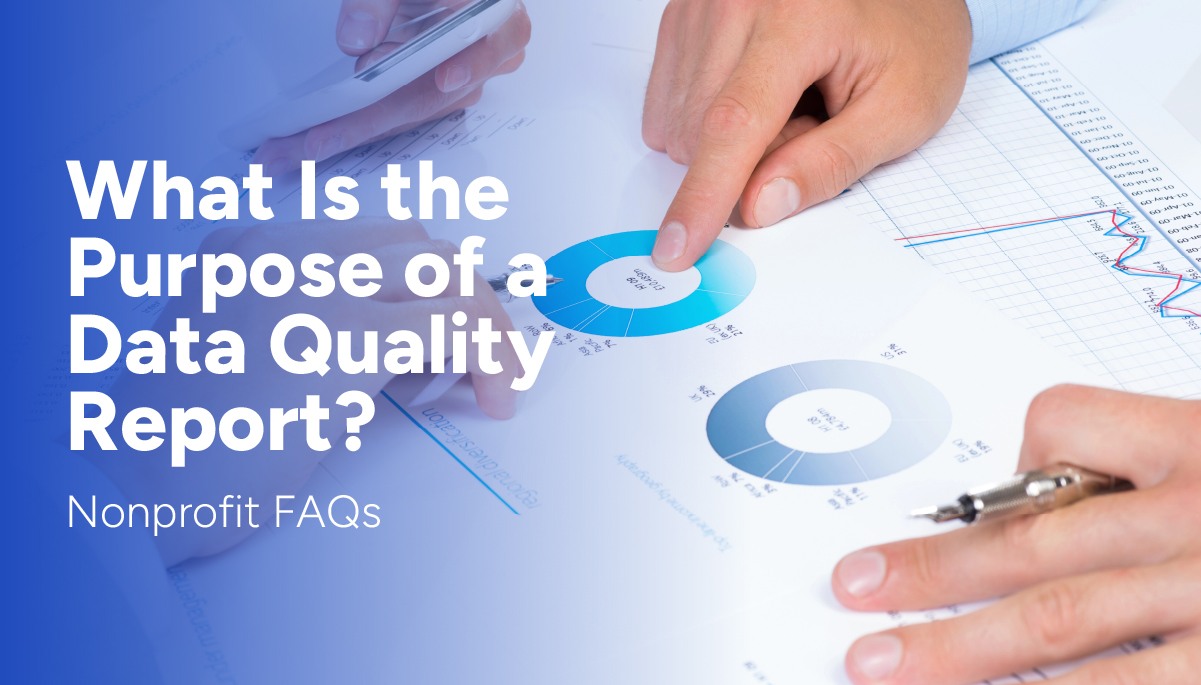What Is the Purpose of a Data Quality Report? Nonprofit FAQs

Data should be at the root of all major nonprofit decisions. When you take a data-driven approach to marketing and fundraising, you’ll be more in tune with supporter interests and preferences, allowing you to connect with them and earn more for your cause.
However, your supporter data must be comprehensive and accurate for it to be useful. With a data quality report, you can ensure your data is as actionable as possible and can act as a resource to inform your marketing and fundraising efforts.
In this guide, we’ll answer any questions nonprofit marketers may have about data quality reports to clear up any confusion and help you get started.
What is a data quality report?
A data quality report assesses the health of your supporter data. It’s an important element of data hygiene, which Deep Sync defines as “the process of keeping databases clean and error-free.”
By partnering with a data provider, you can produce a report that details your data’s accuracy and completeness. While the exact contents of the report may differ between providers, a complete data quality report will indicate:
- The number of confirmed supporter addresses and whether updates are available
- The amount of confirmed phone numbers and whether updates are available
- The number of deceased individuals in your database
- The number of confirmed dates of birth and whether updates are available
- The number of email addresses in your database that can be updated
Overall, the purpose of a data quality report is to assess the accuracy of your existing first-party data. It’s a stepping stone to assessing the gaps in your current data and identifying any third-party data you may need to reach your goals.
What are the benefits of a data quality report?
Did you know that data decays at a rate of 25-30% per year? Without ways to validate your supporter data, it can quickly become outdated and inaccurate.
A data quality report allows you to stay on top of your data, making sure it represents your supporters’ current demographics, interests, and preferences as accurately as possible. When you take this step toward assessing your data’s quality, your organization will be better equipped to:
- Reduce wasted resources. With a better idea of the amount of outdated contact information in your database—such as postal addresses, phone numbers, and email addresses—you’ll have a better grasp of the gaps in your data so you can identify where your messaging may not be reaching your supporters.
- Improve targeting and personalization. When you determine the demographic and lifestyle data that’s missing in your current database, you can choose to append additional data that will kickstart the supporter segmentation process. As a result, you’ll be able to create more highly targeted campaigns that resonate with donors and supporters.
- Enhance audience activation. A data quality report provides the quantity of Personal Identifiable Information (PII) attributes that can be appended to your database, such as names, postal addresses, phone numbers, and email addresses. Once you append this data, your nonprofit can prepare for audience activation across channels and experience improved match rates.
Assessing your data quality and taking action to improve it is a win-win situation. Not only does your nonprofit benefit from improving its return on investment (ROI) by reducing communications to contacts with outdated information, but it becomes possible to fill the gaps in your data with third-party sources.
What are the next steps after receiving a data quality report?
So, your nonprofit has partnered with a data provider and received a data quality report. You may be wondering what to do with this information and how to use it to its fullest potential. We recommend following these steps after acquiring your report:
1. Determine your data priorities.
Meet with your team to discuss the results of the report. Decide which data types are most important to your overall marketing and fundraising goals, and create a plan for obtaining any outdated information. For example, if you decide to enhance your email marketing plan, you’ll need to ensure all supporter email addresses are accounted for and up to date.
2. Enrich your database with third-party attributes.
Once you’ve analyzed your results and determined what types of data you’d like to append, it’s time to enrich your database. Work with your data provider to access high-quality third-party data sources that will help you get a fuller picture of your supporters.
3. Create supporter segments.
After appending additional demographic and lifestyle data to your database, you can begin to group supporters based on shared characteristics. For instance, you may create a segment of local supporters or group donors by age.
4. Develop tailored marketing campaigns.
Leverage your segments to develop personalized marketing campaigns for each group. For example, let’s say you append financial data and create a segment of donors with high giving capacity. Then, you may launch an email marketing campaign promoting unique giving options that would appeal to this group, such as major gifts, planned giving, and donor-advised funds (DAFs).
5. Identify any marketing audiences you’d like to build upon.
Through this data quality assessment and enrichment process, you may discover certain groups that you’d like to target are underrepresented in your database. For instance, an environmental advocacy group may want to reach college students ahead of an upcoming election but have very few records representing this segment. In this case, you can work with your data provider to close this gap by building and activating a custom marketing audience.
6. Establish ongoing data hygiene procedures.
To preserve your data’s quality and keep your data actionable, create internal data hygiene procedures. These may include regularly auditing your database, removing unnecessary information, and developing data entry rules.
With a systematic approach, your nonprofit can make the most of its data quality report and maximize donor engagement and support as a result.
Whether you’re trying to optimize your fundraising plan, improve targeting for your current supporters, or identify opportunities to expand your audience, a data quality report can help you achieve these objectives. Work with a data provider that has experience in both assessing data quality and partnering with nonprofits for the best results.

Comments
Questions or comments? Join the conversation!